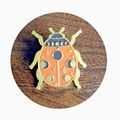Birds - Atlantic Puffin - Pembrokeshire National Park postcard c.1990s
- Condition : Used
- Dispatch : 2 Days
- Brand : None
- ID# : 128323320
- Quantity : 1 item
- Views : 156
- Location : United Kingdom

- Seller : justthebook (+1704)
- Barcode : None
- Start : Mon 19 May 2014 15:16:24 (EDT)
- Close : Run Until Sold
- Remain : Run Until Sold
Checks/Cheques
 for 1 item(s) edit
for 1 item(s) edit
Shipping Calculator
More Listings from This Seller view all
Seller's Description
- Postcard
- Picture / Image: [Atlantic] Puffin - Fratercula arctica - colourful member of the auk family - breeds on Skomer and Skokholm / photo by Mike Alexander
- Publisher: The Pembrokeshire National Park / Parc Cenedlaethol Penfro
- Postally used: yes
- Stamp: 20p green Welsh regional
- Postmark(s): unclear c.1990s
- Sent to: Plymouth
- Notes / condition:
Please ask if you need any other information and I will do the best I can to answer.
Image may be low res for illustrative purposes - if you need a higher definition image then please contact me and I may be able to send one.
------------------------------------------------
Postage & Packing:
UK (incl. IOM, CI & BFPO): 99p
Europe: £1.60
Rest of world (inc. USA etc): £2.75
No additional charges for more than one postcard. You can buy as many postcards from me as you like and you will just pay the fee above once. (If buying postcards with other things such as books, please contact or wait for invoice before paying).
Payment Methods:
UK - PayPal, Cheque (from UK bank) or postal order
Outside UK: PayPal ONLY (unless otherwise stated) please. NO non-UK currency checks or money orders (sorry).
NOTE: All postcards are sent in brand new stiffened envelopes which I have bought for the task. These are specially made to protect postcards and you may be able to re-use them. In addition there are other costs to sending so the above charge is not just for the stamp!
I will give a full refund if you are not fully satisfied with the postcard.
----------------------------------------------
Text from the free encyclopedia WIKIPEDIA may appear below to give a little background information (internal links may not work) :
*************
The Atlantic Puffin (Fratercula arctica), also known as the Common Puffin, is a species of seabird in the auk family. It is the only puffin native to the Atlantic Ocean with two related species, the Tufted Puffin and the Horned Puffin, being found in the north eastern Pacific. The Atlantic Puffin breeds in Iceland, Norway, Greenland, Newfoundland and many North Atlantic islands, and as far south as Maine in the west and the British Isles in the east. The Atlantic Puffin has a large population and a wide range. It is not considered to be endangered although there may be local declines in numbers. On land, it has the typical upright stance of an auk. At sea, they swim on the surface and feed mainly on small fish, which they catch by diving underwater, using their wings for propulsion.
The Atlantic Puffin has a black crown and back, pale grey cheek patches and white underparts. Its broad, boldly marked red and black beak and orange legs contrast with its plumage. It moults while at sea in the winter and some of the bright-coloured facial characteristics are lost. The external appearance of the adult male and female are identical except that the male is usually slightly larger. The juvenile has similar plumage but its cheek patches are dark grey. The juvenile does not have brightly coloured head ornamentation, its bill is less broad and is dark-grey with a yellowish-brown tip, and its legs and feet are also dark. Puffins from northern populations are typically larger than their counterparts in southern parts of the range. It is generally considered that these populations are different subspecies.
The Atlantic Puffin spends the autumn and winter in the open ocean of the cold northern seas and returns to coastal areas at the start of the breeding season in late spring. It nests in clifftop colonies, digging a burrow in which a single white egg is laid. The chick mostly feeds on whole fish and grows rapidly. After about six weeks it is fully fledged and makes its way at night to the sea. It swims away from the shore and does not return to land for several years.
Colonies are mostly on islands where there are no terrestrial predators but adult birds and newly fledged chicks are at risk of attacks from the air by gulls and skuas. Sometimes a bird such as an Arctic Skua will harass a Puffin arriving with a beakful of fish, causing it to drop its catch. The striking appearance, large colourful bill, waddling gait and behaviour of this bird have given rise to nicknames such as ""clown of the sea"" and ""sea parrot"". It is the official bird symbol for the Canadian province of Newfoundland and Labrador.
The Atlantic Puffin is a species of seabird in the order Charadriiformes. It is placed in the family Alcidae of auks, which includes the guillemots, typical auks, murrelets, auklets, puffins and the Razorbill.[3] The Rhinoceros Auklet (Cerorhinca monocerata) and the puffins are closely related, together composing the subfamily Fraterculini.[4] The Atlantic Puffin is the only species in the genus Fratercula to occur in the Atlantic Ocean. Two other species are known from the northeast Pacific, the Tufted Puffin (Fratercula cirrhata) and the Horned Puffin (Fratercula corniculata), the latter being the closest relative of the Atlantic Puffin.[5]
The scientific name Fratercula comes from the Medieval Latin fratercula, friar, a reference to the black and white plumage which resembles monastic robes.[6] The specific name arctica refers to the northerly distribution of the bird, being derived from the Greek ""arktos"", the bear, referring to the northerly constellation, the Great Bear.[7] The vernacular name puffin – puffed in the sense of swollen – was originally applied to the fatty, salted meat of young birds of the unrelated species Manx Shearwater (Puffinus puffinus),[8] which (in 1652) was known as the ""Manks Puffin"". It is an Anglo-Norman word (Middle English pophyn or poffin)[9] used for the cured carcasses. The Atlantic Puffin acquired the name at a much later stage, possibly because of its similar nesting habits,[10] and it was formally applied to Fratercula arctica by Pennant in 1768.[8]
There are generally considered to be three subspecies:[11]
- Fratercula arctica arctica
- Fratercula arctica grabae
- Fratercula arctica naumanni
The only morphological differences between the three would seem to be their size. Body length, wing length and size of beak all increase at higher latitudes. For example, a Puffin from northern Iceland (subspecies naumanii) weighs about 650 grams (23 oz) and has a wing length of 186 millimetres (7.3 in) while one from the Faroes (subspecies grabae) weighs 400 grams (14 oz) and has a wing length of 158 millimetres (6.2 in). Individuals from southern Iceland (subspecies arctica) are intermediate between the other two in size.[12] Ernst Mayr has argued that the differences in size are clinal and are typical of variations found in peripheral population and that no subspecies should be recognised.[13]
type=printed postcards
theme=animals
sub-theme=birds
number of items=single
period=1945 - present
postage condition=posted
Listing Information
| Listing Type | Gallery Listing |
| Listing ID# | 128323320 |
| Start Time | Mon 19 May 2014 15:16:24 (EDT) |
| Close Time | Run Until Sold |
| Starting Bid | Fixed Price (no bidding) |
| Item Condition | Used |
| Bids | 0 |
| Views | 156 |
| Dispatch Time | 2 Days |
| Quantity | 1 |
| Location | United Kingdom |
| Auto Extend | No |



















